Brief Overview of Wood Screws
Wood screws are a fundamental component in woodworking and construction. They are specifically designed to join pieces of wood together securely. These screws are characterized by their partially unthreaded shank and sharp point, which allows them to penetrate wood easily.
Wood screws come in a variety of sizes, types, and materials, each with its unique properties and applications. They are typically made from materials such as steel, brass, stainless steel, or bronze, and they can have different types of drives, such as slotted, Phillips, square, or Torx.
Understanding the different aspects of wood screws is essential for any woodworking project. The right screw can make the difference between a sturdy, long-lasting construction and a weak one that may fail over time.
Our Top Wood Screw Picks
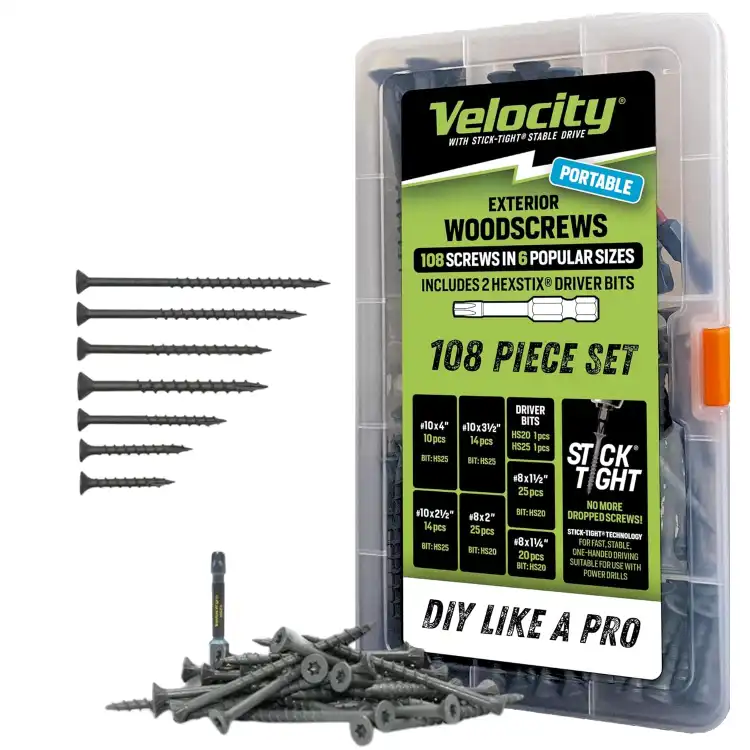
Velocity Exterior Wood Screws
Check on Amazon
Key Specs
- Material: Carbon steel
- Drive system: Phillips with Hexstix drive technology
- Thread size: 0.109375 inches
- Coating: Grey corrosion-resistant black oxide
- Includes 108 pieces in six sizes with 2 drive bits
Velocity Exterior Wood Screws provide a top-tier solution for your woodworking and construction projects. This 108-piece set includes screws in six versatile sizes, each with a corrosion-resistant black oxide coating for enhanced durability. Thanks to the innovative Hexstix drive system, these screws offer a secure fit, reducing wobbling and enabling smooth one-handed installation. The Stick-Tight technology ensures a firm grip for quick, efficient driving, making them perfect for decking, framing, or furniture assembly.
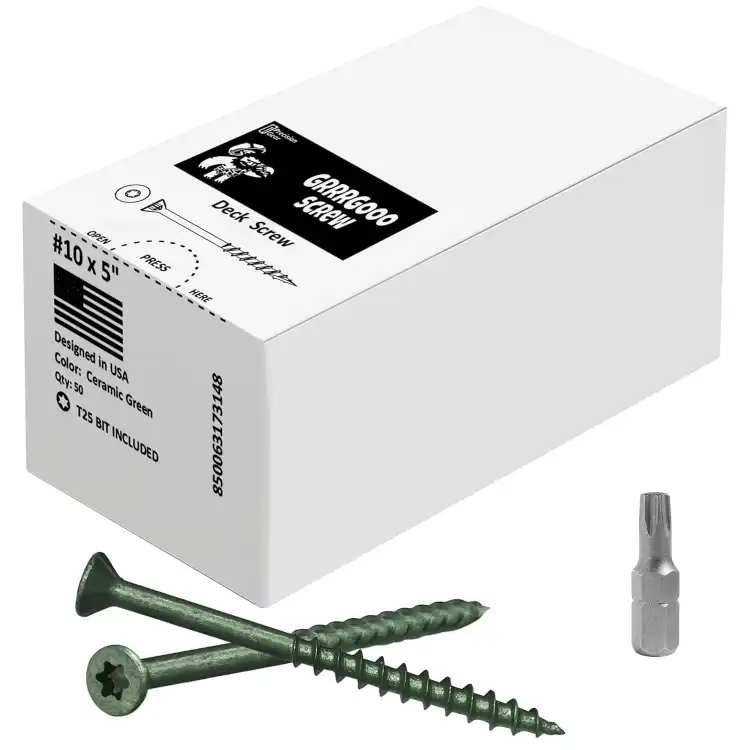
Decking Wood Screws
Check on AmazonKey Specs:
- Material: Carbon steel
- Drive system: Torx
- Head style: Flat
- Exterior finish: Green
- Available in sizes: 2 inches to 6 inches, with packs of 50 or 100 screws
Decking Wood Screws are the perfect solution for your outdoor construction projects. Made from durable carbon steel, these screws feature a flat head and a Torx drive system for effortless installation. The sharp point and optimized thread design allow for smooth, easy driving into wood, minimizing splitting. With superior grip, the deeper, wider threads ensure that your decking remains secure and stable over time, preventing creaky floorboards. Available in green and gold finishes, these screws come in a range of sizes to suit any project, from small patio repairs to larger decking jobs.
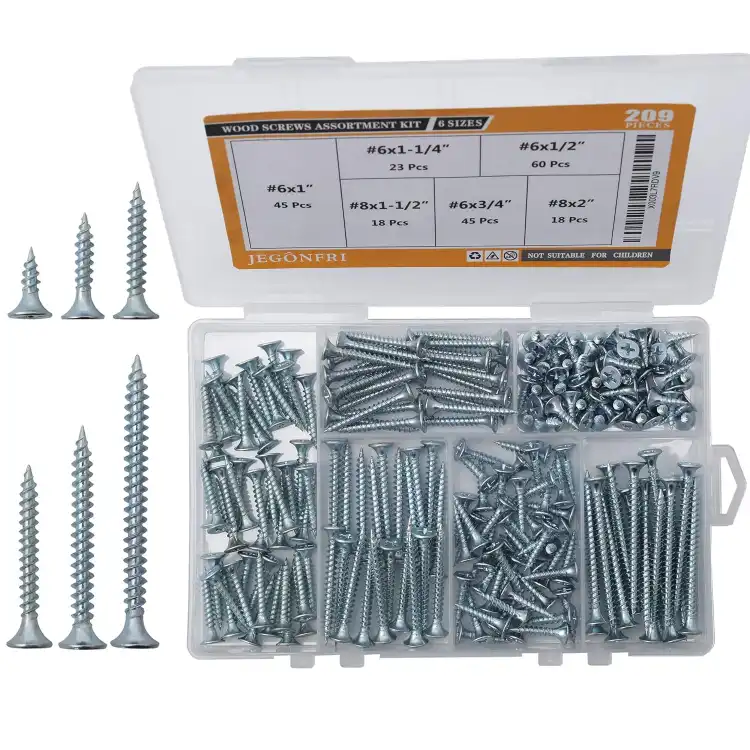
JEGONFRI High Hardness Wood Screws
Check on AmazonKey Specs:
- Material: High hardness 1022A carbon steel
- Drive system: Phillips
- Head style: Flat
- Exterior finish: Zinc
JEGONFRI High Hardness Wood Screws offer a reliable solution for a wide range of projects. This versatile kit contains 209 Phillips screws in 6 different sizes, allowing you to tackle diverse tasks with ease. Made from high-quality 1022A carbon steel, the screws feature a sharp point and heat-treated threads, ensuring quick penetration into wood. The thick galvanized surface provides excellent corrosion resistance, even in salt spray conditions. The screws are neatly organized in a reusable polypropylene box, making it easy to find the right size when needed.
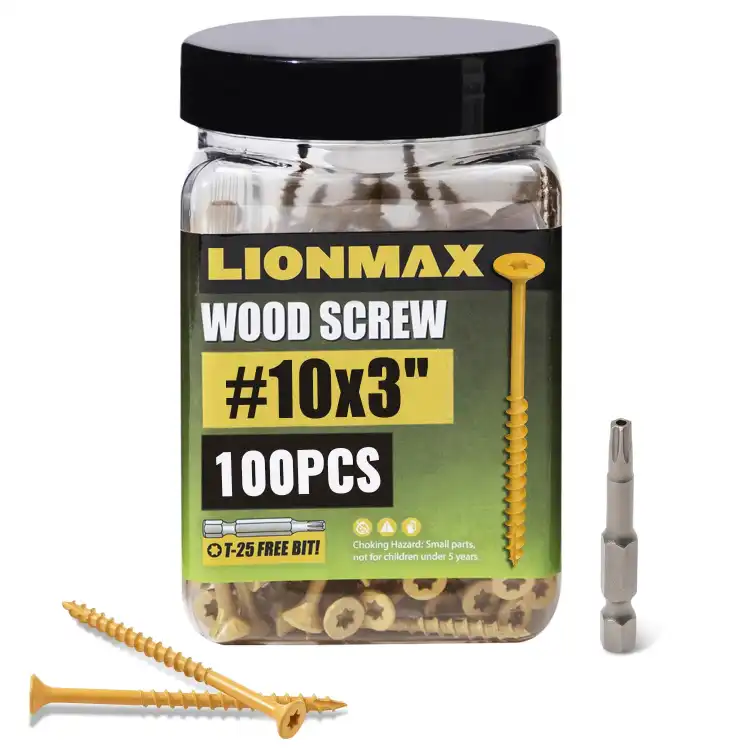
LIONMAX Deck Screws 3 Inch, Wood Screws
Check on AmazonKey Specs:
- Material: Carbon steel
- Drive system: Torx/Star Drive
- Thread size: #10
- Screw length: 3 inches
- Package: 100 pieces with T-25 star drive bit included
LIONMAX 3-inch Deck Screws are designed to provide durable, long-lasting performance for your outdoor wood projects. These screws feature a tan coating that withstood a 1000-hour salt spray test, ensuring they are highly resistant to rust and erosion. The star/Torx drive with 6 contact points reduces the risk of stripping and cam-out, providing a secure fit. Self-tapping points and aggressive threads allow for easy installation without pre-drilling. These screws are perfect for decking, fences, and other wooden structures, offering convenience and reliable protection.
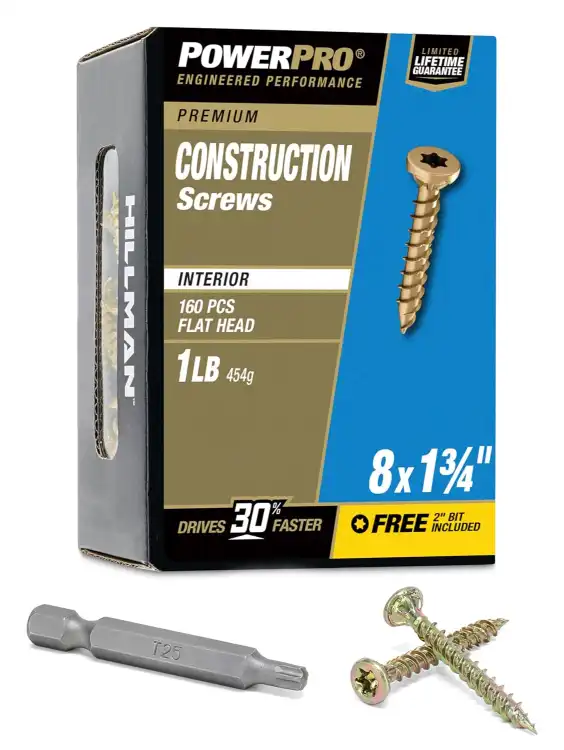
Power Interior Wood Screws
Check on AmazonKey Specs:
- Material: Zinc with epoxy coating
- Drive system: Torx (T20)
- Screw size: #8 x 1-3/4 inches
- Package: 175 pieces with T-20 star driver bit
- Coating: Zinc yellow-chromate for enhanced corrosion resistance
The Power Interior Wood Screws are designed for precision and durability, making them perfect for outdoor wood projects such as decking. With a self-starting tip, they offer 20% faster engagement, and their coarse threads combined with a self-drilling point eliminate the need for pilot holes. Their zinc yellow-chromate coating ensures long-lasting corrosion resistance, and the epoxy finish makes them ideal for pressure-treated wood. The Torx/star drive system minimizes slippage, ensuring a secure and efficient installation.
Importance of Choosing the Right Wood Screws for Projects
Choosing the right wood screws for your project is crucial for several reasons. First, the right screw can significantly enhance the strength and durability of your construction. Different screws are designed for different types of wood and applications, and using the wrong one can lead to weak joints and potential failure of the construction.
Second, the right screw can improve the aesthetics of your project. Screws come in different finishes and head styles, and choosing the right one can add a professional touch to your work. Finally, using the right screw can make your work easier and more efficient, as different screws require different tools and techniques for installation.
Therefore, understanding the different aspects of wood screws and how to choose the right one for your project is an essential skill for any woodworker or DIY enthusiast.
Understanding Wood Screws
Definition and Purpose of Wood Screws
Wood screws are a type of fastener specifically designed for joining pieces of wood. They are characterized by their sharp point and partially unthreaded shank, which allows them to penetrate wood easily and create a strong, secure joint.
The purpose of wood screws is to hold pieces of wood together securely. They are commonly used in woodworking and construction, in applications ranging from furniture making to building houses. Wood screws are designed to create a strong, durable joint that can withstand the stresses and strains of use.
Wood screws work by displacing the wood fibers and then gripping them with their threads. The sharp point of the screw pierces the wood, and as the screw is turned, the threads cut into the wood fibers and pull the screw forward, drawing the two pieces of wood together. The unthreaded portion of the shank allows the top piece of wood to be pulled tight against the lower piece, creating a strong, secure joint.
Different Types of Wood Screws
There are several different types of wood screws, each with its unique properties and applications. The most common types include flat head, round head, and pan head screws, which refer to the shape of the screw head. Flat head screws are designed to sit flush with the surface of the wood, while round head and pan head screws protrude above the surface.
Wood screws also come in different sizes, with the size referring to the diameter and length of the screw. The diameter is typically measured in gauges, with higher gauge numbers indicating larger diameters. The length is measured in inches or millimeters, and it refers to the length of the threaded portion of the screw.
Finally, wood screws can have different types of drives, such as slotted, Phillips, square, or Torx. The type of drive refers to the shape of the recess in the screw head that accepts the screwdriver or drill bit. The type of drive can affect the ease of installation and the amount of torque that can be applied to the screw.
Factors to Consider When Buying Wood Screws
Material of the Screw
The material of the screw is one of the most important factors to consider when buying wood screws. The material can affect the strength, durability, and corrosion resistance of the screw.
Steel screws are the most common type of wood screws. They are strong and durable, but they can rust if exposed to moisture. Brass screws are softer and less strong than steel screws, but they are highly resistant to corrosion and are often used for decorative purposes. Stainless steel screws are highly resistant to corrosion and are often used in outdoor applications. Bronze screws are also highly resistant to corrosion and are often used in marine applications.
When choosing the material of the screw, it’s important to consider the environment in which the screw will be used. If the screw will be exposed to moisture or corrosive substances, a corrosion-resistant material like stainless steel or bronze may be the best choice.
Size of the Screw
The size of the screw is another important factor to consider. The size refers to the diameter and length of the screw, and it can affect the strength of the joint and the ease of installation.
The diameter of the screw should be chosen based on the thickness of the wood pieces to be joined. As a general rule, the diameter of the screw should be less than half the thickness of the thinnest piece of wood. This helps to prevent splitting of the wood.
The length of the screw should be chosen based on the depth of the joint. The screw should be long enough to penetrate the lower piece of wood by at least half its thickness, but not so long that it protrudes out the other side. This ensures a strong, secure joint.
Type of Drive
The type of drive refers to the shape of the recess in the screw head that accepts the screwdriver or drill bit. The type of drive can affect the ease of installation and the amount of torque that can be applied to the screw.
Slotted drives are the simplest and most traditional type of drive, but they can be difficult to use with power tools because the bit can easily slip out of the slot. Phillips drives are more modern and are designed to allow the bit to slip out of the drive when the screw is fully tightened, preventing over-tightening. Square and Torx drives are even more modern and are designed to provide better contact between the bit and the screw, allowing for higher torque and easier installation.
When choosing the type of drive, it’s important to consider the tools you have available and your comfort level with using them. If you’re comfortable using power tools and want to be able to apply high torque, a square or Torx drive may be the best choice. If you’re more comfortable using hand tools, a slotted or Phillips drive may be more suitable.
Thread Count
The thread count refers to the number of threads per inch or per centimeter on the screw. The thread count can affect the holding power of the screw and the ease of installation.
Coarse-threaded screws have fewer threads per inch or per centimeter and are easier to install in softwoods. They displace more wood fibers, which allows them to grip the wood more effectively. Fine-threaded screws have more threads per inch or per centimeter and are more suitable for hardwoods. They displace fewer wood fibers, which reduces the risk of splitting the wood.
When choosing the thread count, it’s important to consider the type of wood you’ll be working with. If you’re working with softwoods, a coarse-threaded screw may be the best choice. If you’re working with hardwoods, a fine-threaded screw may be more suitable.
Point Type
The point type refers to the shape of the tip of the screw. The point type can affect the ease of installation and the risk of splitting the wood.
Sharp-pointed screws are the most common type of wood screws. They are designed to pierce the wood and start the hole for the screw. However, they can cause splitting in some types of wood, especially if the screw is installed near the edge of the piece.
Type 17 screws have a small cut at the tip, which helps to remove wood fibers and reduce the risk of splitting. Self-drilling screws have a drill-like point that can create its own hole, eliminating the need for pre-drilling. However, they can be more difficult to install and may not be suitable for all applications.
When choosing the point type, it’s important to consider the type of wood you’ll be working with and the location of the screw. If you’re working with a wood that’s prone to splitting or if the screw will be installed near the edge of the piece, a Type 17 or self-drilling point may be the best choice.
Detailed Explanation of Wood Screw Materials
Steel Screws
Steel screws are the most common type of wood screws. They are made from carbon steel, which is strong and durable. Steel screws can be coated with a variety of finishes to enhance their appearance and increase their corrosion resistance.
Zinc-plated steel screws are the most common type of steel screws. The zinc plating provides a moderate level of corrosion resistance, making these screws suitable for indoor applications. However, they can rust if exposed to moisture for extended periods.
Black oxide steel screws have a black finish that provides a moderate level of corrosion resistance and a sleek, modern appearance. They are often used in furniture and other indoor applications where aesthetics are important.
Chrome-plated steel screws have a bright, shiny finish that provides a high level of corrosion resistance. They are often used in automotive and other applications where a high level of corrosion resistance is required.
Brass Screws
Brass screws are made from an alloy of copper and zinc. They are softer and less strong than steel screws, but they are highly resistant to corrosion. Brass screws have a golden color that can add a decorative touch to your project.
Brass screws are often used in furniture and other indoor applications where aesthetics are important. They are also used in outdoor applications where a high level of corrosion resistance is required, such as in marine environments.
When working with brass screws, it’s important to be careful not to over-tighten them, as they can easily strip or break. Pre-drilling holes is recommended to reduce the risk of breaking the screw.
Stainless Steel Screws
Stainless steel screws are made from an alloy of steel and chromium. They are highly resistant to corrosion and are often used in outdoor applications where they will be exposed to moisture or corrosive substances.
Stainless steel screws are stronger than brass screws, but not as strong as steel screws. They have a silver color that can add a modern touch to your project.
When working with stainless steel screws, it’s important to be aware that they can gall (stick together) if over-tightened. To prevent galling, it’s recommended to lubricate the screw before installation.
Bronze Screws
Bronze screws are made from an alloy of copper and tin. They are highly resistant to corrosion and are often used in marine applications where they will be exposed to salt water.
Bronze screws are stronger than brass screws, but not as strong as steel or stainless steel screws. They have a dark brown color that can add a rustic touch to your project.
When working with bronze screws, it’s important to be careful not to over-tighten them, as they can easily strip or break. Pre-drilling holes is recommended to reduce the risk of breaking the screw.
Understanding Wood Screw Sizes
Diameter
The diameter of a wood screw refers to the thickness of the screw’s shank. It is typically measured in gauges, with higher gauge numbers indicating larger diameters. The diameter of the screw can affect the strength of the joint and the risk of splitting the wood.
As a general rule, the diameter of the screw should be less than half the thickness of the thinnest piece of wood. This helps to prevent splitting of the wood. For example, if you’re joining two pieces of 1-inch thick wood, you should use a screw with a diameter of less than 1/2 inch.
It’s also important to consider the type of wood you’re working with. Hardwoods are denser and stronger than softwoods, so they can accommodate larger diameter screws. However, they are also more prone to splitting, so it’s important to pre-drill holes when using larger screws.
Length
The length of a wood screw refers to the length of the threaded portion of the screw. It is typically measured in inches or millimeters. The length of the screw can affect the depth of the joint and the holding power of the screw.
The screw should be long enough to penetrate the lower piece of wood by at least half its thickness, but not so long that it protrudes out the other side. For example, if you’re joining a 1-inch thick piece of wood to a 2-inch thick piece of wood, you should use a screw that’s at least 1 inch long, but not more than 2 inches long.
It’s also important to consider the type of joint you’re creating. For example, if you’re creating a butt joint (where the end of one piece of wood is joined to the side of another piece), you’ll need a longer screw than if you’re creating a lap joint (where two pieces of wood overlap).
Gauge
The gauge of a wood screw refers to the thickness of the screw’s shank. It is typically measured in numbers, with higher numbers indicating larger gauges. The gauge of the screw can affect the strength of the joint and the risk of splitting the wood.
As a general rule, the gauge of the screw should be less than half the thickness of the thinnest piece of wood. This helps to prevent splitting of the wood. For example, if you’re joining two pieces of 1-inch thick wood, you should use a screw with a gauge of less than 1/2 inch.
It’s also important to consider the type of wood you’re working with. Hardwoods are denser and stronger than softwoods, so they can accommodate larger gauge screws. However, they are also more prone to splitting, so it’s important to pre-drill holes when using larger screws.
Different Types of Wood Screw Drives
Slotted Drive
Slotted drive screws are the simplest and most traditional type of wood screws. They have a single slot in the head that accepts a flat-blade screwdriver. Slotted drive screws are easy to install with hand tools, but they can be difficult to use with power tools because the bit can easily slip out of the slot.
Slotted drive screws are often used in furniture and other applications where a traditional appearance is desired. They are available in a wide range of sizes and materials, making them suitable for a variety of applications.
When working with slotted drive screws, it’s important to use a screwdriver that fits the slot properly. A screwdriver that’s too small can slip out of the slot and damage the screw or the surrounding wood. A screwdriver that’s too large can widen the slot and strip the head of the screw.
Phillips Drive
Phillips drive screws are a modern type of wood screws. They have a cross-shaped slot in the head that accepts a Phillips screwdriver. Phillips drive screws are designed to allow the bit to slip out of the drive when the screw is fully tightened, preventing over-tightening.
Phillips drive screws are often used in construction and other applications where a high level of torque is required. They are available in a wide range of sizes and materials, making them suitable for a variety of applications.
When working with Phillips drive screws, it’s important to use a screwdriver that fits the drive properly. A screwdriver that’s too small can slip out of the drive and damage the screw or the surrounding wood. A screwdriver that’s too large can strip the drive and make the screw difficult to remove.
Square Drive
Square drive screws are a modern type of wood screws. They have a square-shaped recess in the head that accepts a square drive bit. Square drive screws are designed to provide better contact between the bit and the screw, allowing for higher torque and easier installation.
Square drive screws are often used in construction and other applications where a high level of torque is required. They are available in a wide range of sizes and materials, making them suitable for a variety of applications.
When working with square drive screws, it’s important to use a bit that fits the drive properly. A bit that’s too small can slip out of the drive and damage the screw or the surrounding wood. A bit that’s too large can strip the drive and make the screw difficult to remove.
Torx Drive
Torx drive screws are a modern type of wood screws. They have a star-shaped recess in the head that accepts a Torx bit. Torx drive screws are designed to provide better contact between the bit and the screw, allowing for higher torque and easier installation.
Torx drive screws are often used in automotive and other applications where a high level of torque is required. They are available in a wide range of sizes and materials, making them suitable for a variety of applications.
When working with Torx drive screws, it’s important to use a bit that fits the drive properly. A bit that’s too small can slip out of the drive and damage the screw or the surrounding wood. A bit that’s too large can strip the drive and make the screw difficult to remove.
Importance of Thread Count in Wood Screws
Coarse Threads
Coarse-threaded screws have fewer threads per inch or per centimeter. They displace more wood fibers, which allows them to grip the wood more effectively. Coarse-threaded screws are easier to install in softwoods and are often used in construction and other applications where a strong, secure joint is required.
When working with coarse-threaded screws, it’s important to pre-drill holes to reduce the risk of splitting the wood. The hole should be slightly smaller than the diameter of the screw, allowing the threads to grip the wood and create a strong joint.
It’s also important to use a screwdriver or drill that fits the drive of the screw properly. A tool that’s too small can slip and damage the screw or the surrounding wood. A tool that’s too large can strip the drive and make the screw difficult to remove.
Fine Threads
Fine-threaded screws have more threads per inch or per centimeter. They displace fewer wood fibers, which reduces the risk of splitting the wood. Fine-threaded screws are more suitable for hardwoods and are often used in furniture making and other applications where a clean, precise joint is required.
When working with fine-threaded screws, it’s important to pre-drill holes to reduce the risk of splitting the wood. The hole should be slightly smaller than the diameter of the screw, allowing the threads to grip the wood and create a strong joint.
It’s also important to use a screwdriver or drill that fits the drive of the screw properly. A tool that’s too small can slip and damage the screw or the surrounding wood. A tool that’s too large can strip the drive and make the screw difficult to remove.
Understanding Point Types of Wood Screws
Sharp Point
Sharp-pointed screws are the most common type of wood screws. They are designed to pierce the wood and start the hole for the screw. Sharp-pointed screws are easy to install and provide a strong, secure joint.
However, sharp-pointed screws can cause splitting in some types of wood, especially if the screw is installed near the edge of the piece. To reduce the risk of splitting, it’s important to pre-drill holes for the screws. The hole should be slightly smaller than the diameter of the screw, allowing the threads to grip the wood and create a strong joint.
When working with sharp-pointed screws, it’s important to use a screwdriver or drill that fits the drive of the screw properly. A tool that’s too small can slip and damage the screw or the surrounding wood. A tool that’s too large can strip the drive and make the screw difficult to remove.
